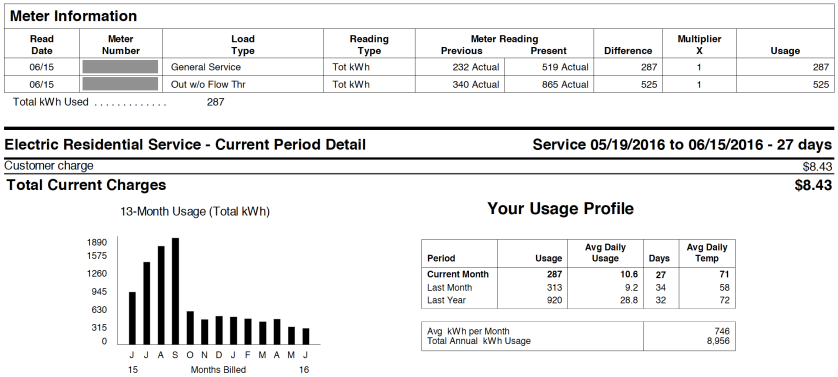This post will explore the PECO power bill, before and after going solar. Be sure to check out the “Interesting Issue” near the end of this post.
Looking at a sample of page 2 of a PECO electric bill before going solar, you’ll see
- one meter reading showing monthly usage (451 kWh in our sample)
- one fixed Customer charge of $8.44
- three charges based on usage for Generation, Transmission & Distribution.

If you’ve gone to PAPowerSwitch and selected another electricity supplier, then you would see Generation & Transmission combined onto one line, with the rate set by that supplier.
On your first month with solar, it will be a bit complicated for two reasons.
- PECO charges the installer for the new meter (part of your payment to the installer), and then PECO gives you a credit on your bill. The amount is between $300 and $400.
- You’ll therefore be billed part of the month with the old meter, and the remainder with the new meters.
You’ll see a bill like the one below with 3 meter readings:
- Old meter reading, partial month’s usage before switch to solar (sample: 81 kWh)
- New “in” meter (also called general service) for electricity you used from PECO (sample :232 kWh)
- New “out” meter, for electricity your rooftop system sent to PECO (sample 340 kWh)
plus a Customer charge of $8.43 (or 8.44, not sure why it varies a little).
What this means:
The energy from solar that was sent back to PECO was 27 kWh more than the amount received from PECO (340 – 232 – 81). This surplus 27 kWh will be banked towards next month’s use. You are billed just the Customer charge of $8.43 for the month.

To make it more complicated, for this particular bill, the 27 kWh surplus resulted in a “Renewable Energy Credit” of $2.15 because the bill happened to be in May which is the month when PECO zero’s out the banked distribution of kWhs. They call this “settlement.”
This plus the credit mentioned earlier, for the meter, results in a total credit of $327.06. Given that the customer charge was $8.43 the bill ends up with a credit of $318.63 that will be carried over to the next month. The image below is Page 1 of the May bill.
Note the “Message Center” which describes the “banked distribution” and the “settlement.”

The following months, when your grid-connected system is in full swing, you’ll see a bill like the one below:
- 2 meter readings:
“In” meter, for electricity you used from PECO, (sample 287 kWh)
“Out” meter, for electricity your rooftop system sent to PECO, (sample 525 kWh)
- Customer charge $8.43
In the example, 238 kWh more electricity was sent to the grid than you pulled down (525-287) . The surplus will go into your “banked distribution” and will be added to next month’s “out” meter reading to determine next month’s bill. If the total of these two is more than the “in” meter, then no charge, if it is ever less than the “in” meter, then you will see the three charges for generation, transmission and distribution for the extra kWh’s used. This rollover and comparison will occur each month until the next May. In May, PECO will zero out the surplus “banked distribution” with a check or a credit on the bill.

INTERESTING ISSUE – There is one piece of usage information that is not visible on the PECO bill: How much electricity was actually consumed by the loads in the house. Since solar energy is used by the house loads first, PECO does not see this energy so can not meter this energy.
On the 13-Month Usage chart shown above, compare the usage for the prior year’s month of June, before the solar installation, to June of the current year which was after the solar installation. The current year is significantly lower than the prior year. This is because the big usage in June is the air conditioner, and the air conditioner tends to be on during the day when the sun is out and power is being generated by the panels. This is a clear picture of the value of solar because the electricity for the air conditioning load never had to enter the electrical grid. The electricity was consumed right where it was generated.
The load information is not lost to the homeowner as it is being tracked by the monitoring system from the solar company which is used to track the output of the solar arrays.
This data in combination with the information available on the PECO bill will allow a full picture of the energy flow.







